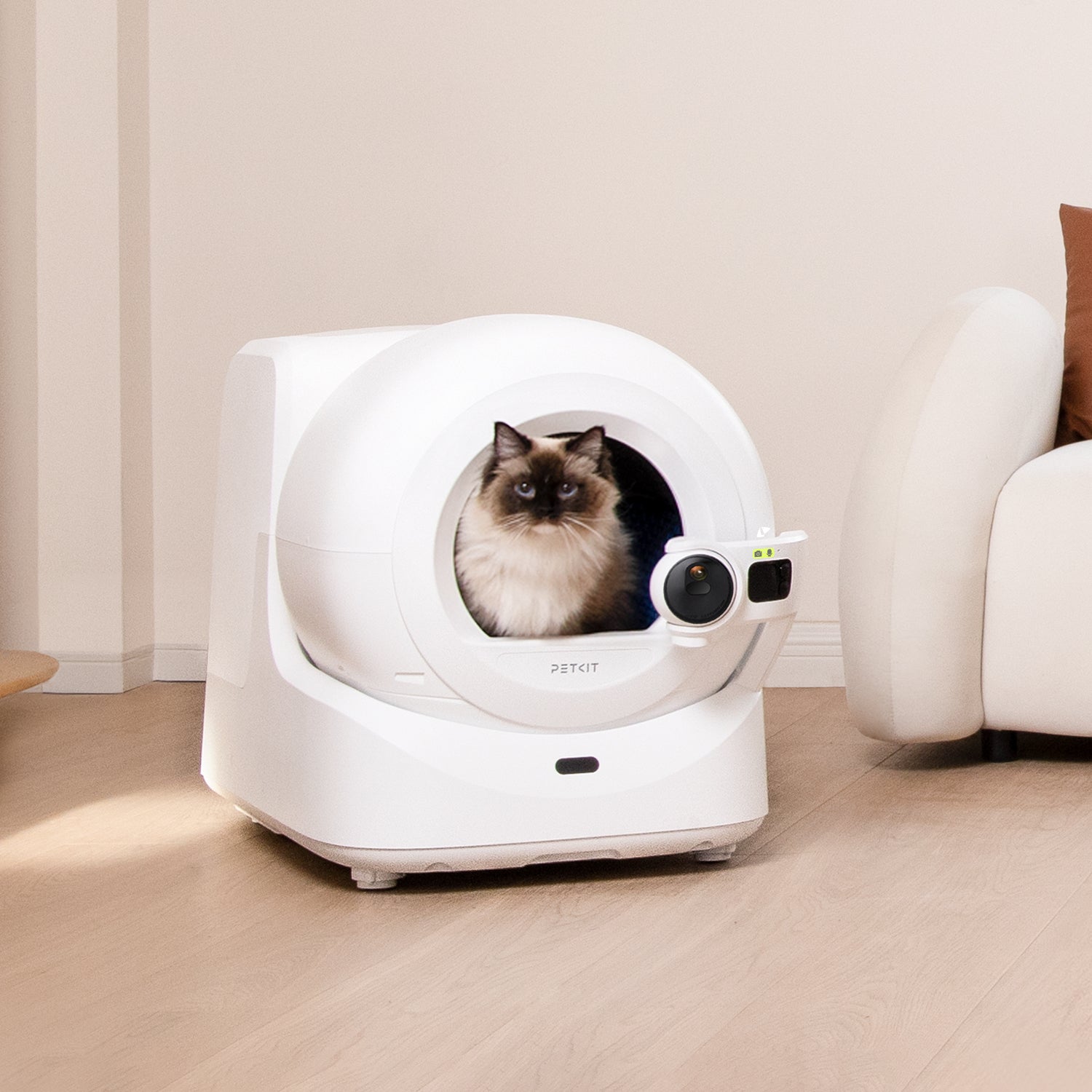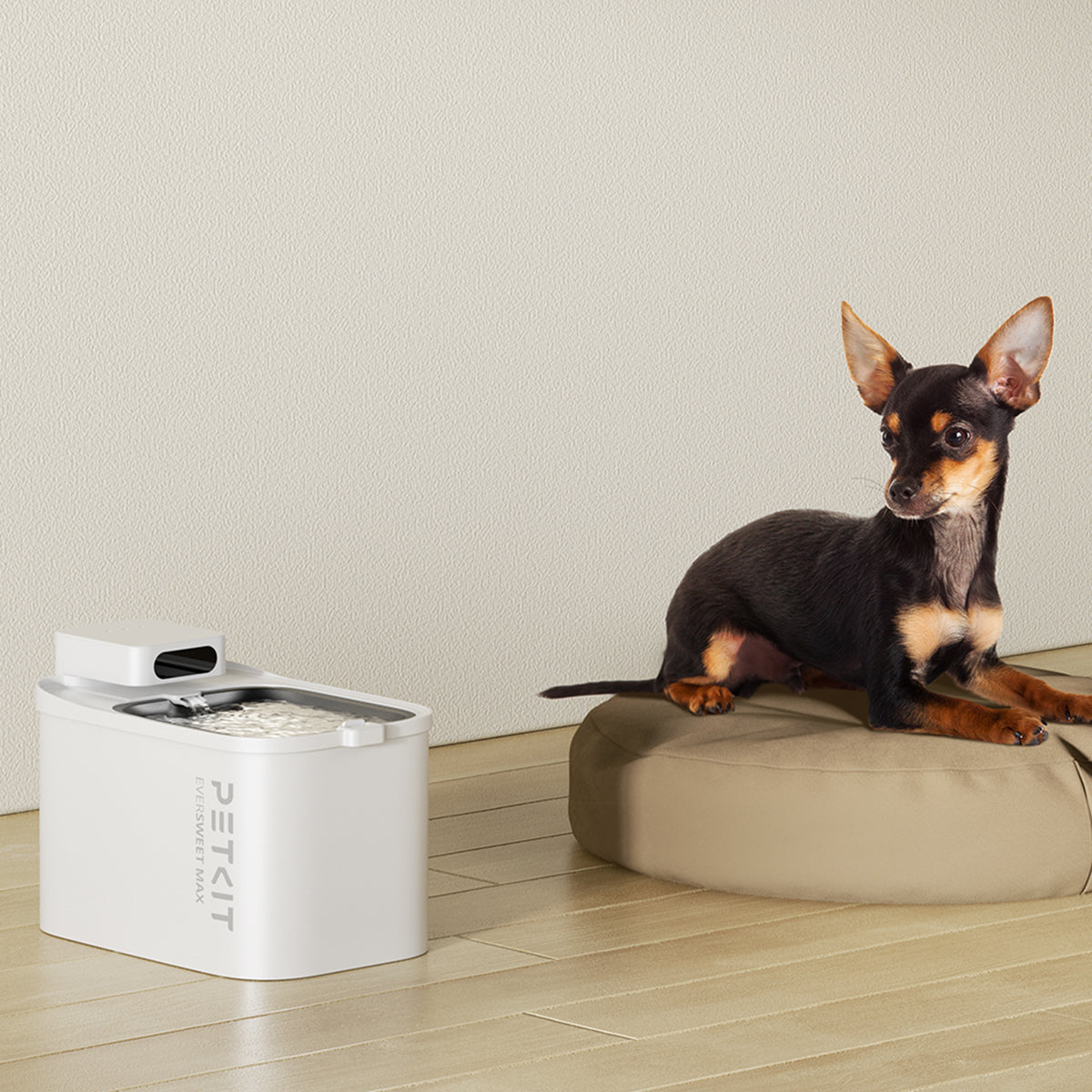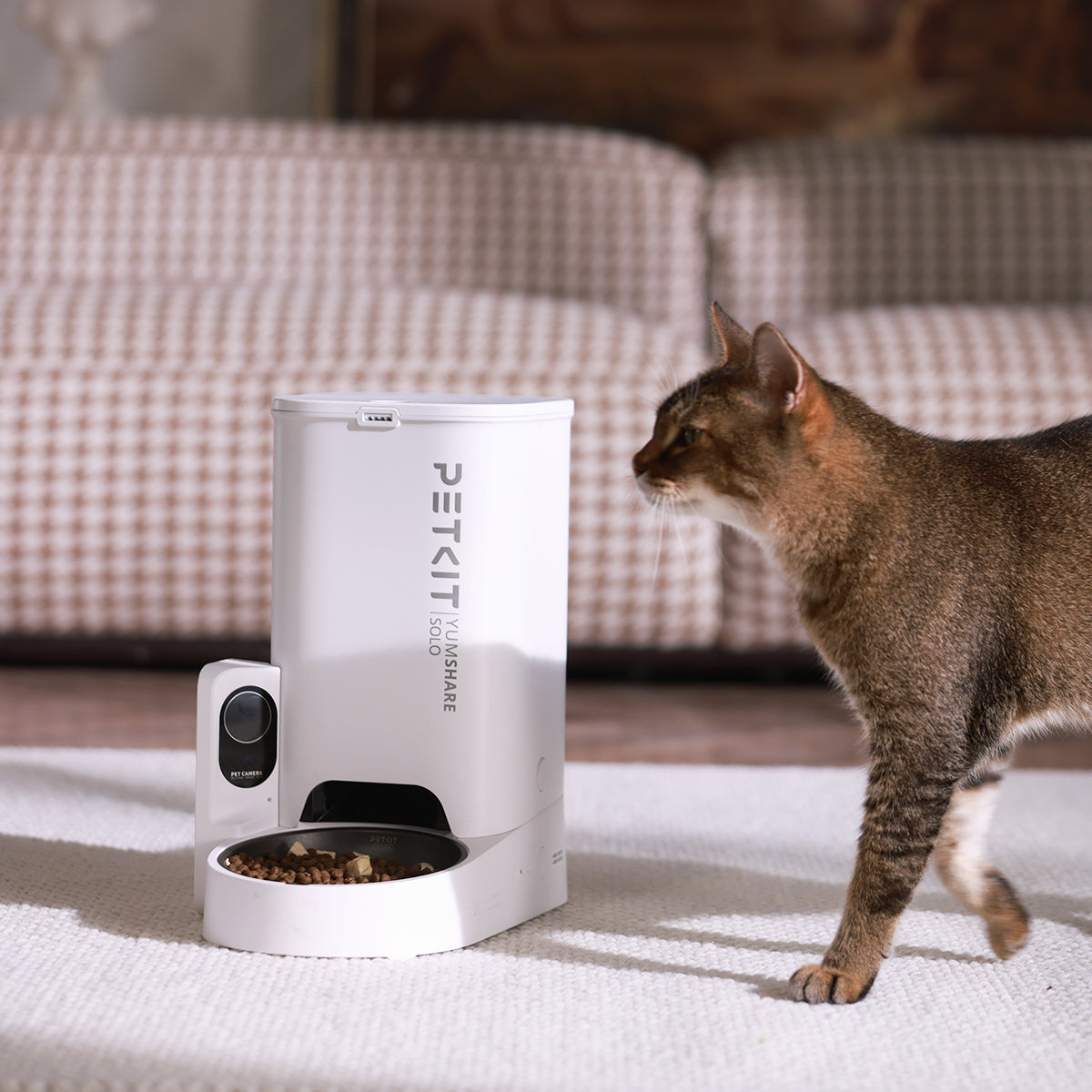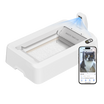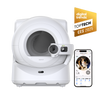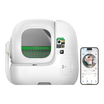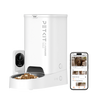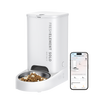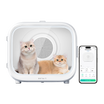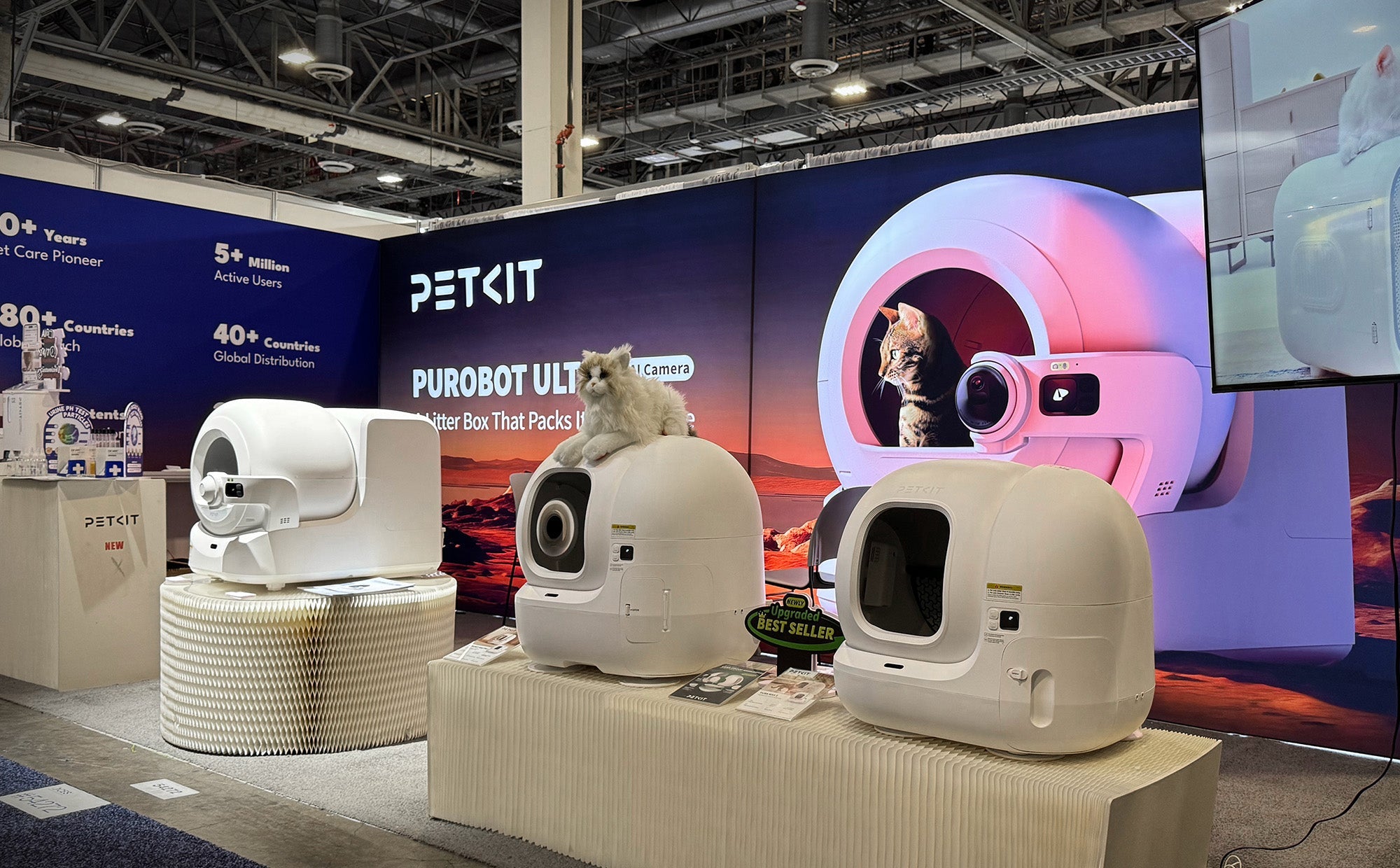What if your smart pet health monitor started with your cat's litter box? In a recent roundtable discussion, veterinary luminaries and pet care experts tackled the silent crisis facing America's 42.1 million cat-owning households - the staggering rate of undetected feline health issues. From preventing life-threatening conditions to transforming daily pet care, discover why these experts believe the future of feline health starts in the most unexpected place - the litter box.
Expert Panel: Background and Qualifications
PANEL OVERVIEW (00:08~07:35):
Led by Emmy Award-winning veterinarian Dr. Jeff Werber, the expert panel brings together 40+ years of clinical experience, UC Davis veterinary excellence, and social media advocacy. Dr. Sarah Wooten shares 16 years of small animal practice insights, while Nathan The CatLady bridges rescue work with modern pet parent outreach, and Dr. Jill Goldman contributes vital behavioral expertise from working with multiple species.
PETKIT (00:24)
Welcome to Are You Missing Silent Cat Health Signals? Experts’ Litter Box Debate, hosted by PETKIT. My name is Summer, and I'm excited to bring together leading voices in veterinary medicine, animal behavior, and pet care to discuss one of the most underestimated topics: litter box care.
The reason we are hosting this roundtable is simple—the statistics are concerning. Despite 42.1 million cat-owning households today, a 2020 animal study found that only 40% of pet owners visit the vet annually. Research from Walton and the University of Bristol reveals that over 50% of cat health issues go untreated, highlighting the critical need for proactive monitoring and early intervention. Our goal today is to shed light on these silent health signals, provide practical advice, and explore how technology can help bridge the gap to better pet care.
We'll cover why monitoring your cat's litter box habits is so important, the unique challenges faced by multi-cat households, and innovative solutions to make preventative care more accessible. We are excited to have Emmy Award-winning veterinarian Dr. Jeff Werber—famously known as the best vet in LA—as our moderator. With his expertise and charisma, Dr. Werber will guide us through these critical topics, and maybe even settle a few debates along the way.
Dr. Jeff Werber, DVM (02:00)
Certainly! So, I don't know about charisma, but experience—yes. I'm a 1984 graduate of UC Davis, and I've been doing this for just over 40 years. For me, it's been a joy. I mean, you're going to have to pull me away kicking and screaming. I'm a pet lover—one of those "idiot vets" who wanted to do this since I was five years old. Here I am, 40-plus years in, and I still love it.
I practice daily. We have nine pets at home because, apparently, I don’t get enough at the office every day. So, I come home to five dogs and four cats. Being a dad of four cats, this is, of course, a very interesting topic for me. I'm thrilled to be here and to introduce you to our wonderful team of experts from very different fields.
So, in no particular order other than how it’s showing up on my screen—let’s start with the upper right for me, which is Dr. Sarah Wooten, who’s also a veterinarian and a colleague. Sarah, tell us a bit about yourself and how you got interested in this.
Sarah J. Wooten, DVM, CVJ (03:06)
Hi Jeff, hi everybody, and thanks for introducing me. My name is Dr. Sarah Wooten, and I am also a UC Davis graduate, class of 2002. I tracked small animals and practiced for 16 years. During that time, I realized there was still a long way to go in terms of education, technology, and tools that could help pet parents better care for their animals.
We were actually missing a lot of diseases, and instead of being proactive, we were putting out fires that could have been caught earlier—making it easier and better for the pet. So, I’m really interested in things like this because I love new technologies that can help pet parents monitor their animals better.
And also, this is really interesting to me as a veterinarian because of the data piece. Because a lot of times, when we're in the practice, we only get a snapshot of what the pet parent is telling us. But if we knew what was happening over the past month, that would be amazing. So something like this is really interesting to me as far as a way to help cats and their families.
Dr. Jeff Werber, DVM (04:13)
Wonderful. Next up on my screen—Nathan, you know, it’s funny, I have to say, calling yourself a cat lady, because I often tease people that I’m a cat lady. So let’s hear your background and what brought you here to us. I love talking about cats.
Nathan The CatLady (04:30)
Yeah. Absolutely. So, I started out as an actor out here in Los Angeles and began building a social media presence. I had four cats and started posting some videos with them that went viral. Eventually, I just leaned into it. Like you said, I was getting called a crazy cat lady, and I thought, “I’m going to lean into it, and we’re going to make it cool.” I was kind of sick of the stereotype, so I made myself Nathan The CatLady and just ran with it.
Then, I started learning about rescue and how important it was, so I jumped into rescue work. Since then, I’ve gotten to work with pretty much every pet brand in the industry, seeing what’s coming out and what new products are available. Hi, Ginger! I also have a large following of cat lovers, so I’m constantly hearing what’s going on with people and their pets, as well as what they’re curious about.
And now, I’m out here exploring where the world of cat people and cat ladies is going and what new technologies are coming to help out.
Dr. Jeff Werber, DVM (05:28)
So, how many cats do you have?
Nathan The CatLady (05:30)
I have four.
Dr. Jeff Werber, DVM (05:31)
You have four? Okay, me too. Interestingly, side note—we moved to California from New York back in the early ’60s because my dad was an actor. So, I’ve got some great stories about that too.
All right, next up—Jill. Dr. Jill Goldman, PhD, and an animal behaviorist for cats and dogs. Tell us about yourself and how you got here.
Jill A. Goldman, PhD, MSc, CAAB (05:54)
Hi, I’m so happy to be here, everybody. So, I’m an animal behaviorist—a certified animal behaviorist. My background includes working with some other creatures besides companion animals, namely wolves, monkeys, and some farm animals.
I earned my PhD at York University, working with monkeys, and my Master’s of Science at Dalhousie University in Halifax, working with wolves. Then, I went to New York City, where I worked with the American Society for the Prevention of Cruelty to Animals (ASPCA) at a shelter. There, I became very familiar with the companion animal population, the shelter population, and the issues that people and animals have to deal with on a regular basis.
Since then, I’ve moved to California and am now based in Los Angeles. I have a private practice, and I work with shelters as well as pet parents. What we’re seeing is that, number one, shelters are being overrun. It’s really important for pet parents to understand what’s going on at home so that their pet can stay at home instead of being returned. It’s also important to understand their behavior, so we’re not waiting until the last minute to address major problems that can’t be dealt with.
I work with dogs, cats, and people, and it keeps me very busy. I’m hoping we can find solutions to keep animals at home so they don’t end up in shelters and to get animals from shelters into forever homes.
Dr. Werber, why don't you take it from here, share a little bit about your incredible journey, and introduce our fantastic panelists for today.
Silent Signals: Understanding Feline Preventive Care
KEY INSIGHTS (07:36~12:54):
Veterinary experts emphasize how monitoring plays a vital role in pet health outcomes. Clinical cases demonstrate how subtle changes, when caught early through pet health apps, can prevent serious health issues. Dr. Wooten shares compelling examples where earlier detection of changes in toileting habits and weight could have led to better outcomes, highlighting how daily monitoring directly impacts treatment success and cat survival rates.
Dr. Jeff Werber, DVM (07:36)
So, I thank you all for being a part of this team. I’m glad—so glad—you mentioned working with the people too, because, you know, there’s only so much you can do with the pets. It’s easier, I’m sure, to work with the cats and dogs than it is to train the owners—the pet parents—to do what’s right.
We all agree that monitoring plays such a critical role in overall pet health.
Q: So, I want to know, when it comes to litter box behavior and monitoring, what are your thoughts on the role it plays? How does it help us as cat people—and pet people in general—keep their pets’ lives healthier? Dr. Sarah, do you agree that a large percentage of cats could live longer if we focused more on preventive care? Specifically, by understanding and recognizing the early signs through monitoring?
Sarah J. Wooten, DVM, CVJ (08:41)
Well, 100% yes. I mean, knowledge is power, and data is power—especially when it comes to tracking trends in your pet’s health. I can think of a couple of cases in my own clinical practice where, if the owner had only known earlier, there was a problem, we could have saved the cat.
I remember back when I was fresh out of vet school, and a young man came in with his cat. The cat was older, and he loved this cat so much. He said, “I don’t know, he’s just not doing well, doc.” Of course, I pet the cat, and it was like petting a furry skeleton—it was so skinny. Have you ever petted a cat like that? You can’t tell when you’re looking at them because they’re covered in fur, but I could feel it.
The cat had chronic kidney disease and had had it for quite some time. The owner was devastated, ashamed, and sad that he didn’t know because he hadn’t tracked the cat’s toileting habits. He didn’t realize the cat was peeing a lot more than usual.
So, definitely—I mean, that’s just one of hundreds of cases. It probably happened on a daily basis when I was in practice.
Dr. Jeff Werber, DVM (09:59)
Q: And Dr. Jill, how do behavior changes often signal potential health issues?
Jill A. Goldman, PhD, MSc, CAAB (10:05)
We are finding out more and more that there’s an underlying medical issue in a lot of behavioral cases. Not to say that there are no behavioral problems that are independent, but they are often a manifestation of medical issues.
What we’re seeing is that if we had some information about—one, how the cat is not going to the litter box—maybe he has arthritis problems, maybe he’s too old, maybe he needs some modification, or maybe he’s undergoing stress.
In order to get an idea of why the animal is behaving out of the norm, we always want to look at any medical issues that could be underlying the behavior. And litter box issues are a really good indicator of what’s happening with the cat’s overall health, as well as their welfare.
Dr. Jeff Werber, DVM (11:03)
I totally agree, and I think that many times pet parents overlook that. Nathan, you mentioned that you also work a lot with rescues and shelters and things like that. With that experience, you see the challenges they face daily, especially with unwanted cats. Again, I have four cats, and I recently had five for a reason—it’s because they’re all from rescues and shelters.
Nathan The CatLady (11:25)
Mm-hmm.
Dr. Jeff Werber, DVM (11:29)
Q: What seems to be driving the problem that so many cats are either being brought in or not being adopted?
Nathan The CatLady (11:37)
Well, one of the...
Jill A. Goldman, PhD, MSc, CAAB (11:38)
House soiling issues—litter box issues—are one of the main reasons why cats are surrendered to shelters. If we can fix that problem and address it when it first starts to be revealed, then we can keep a lot of cats at home.
Dr. Jeff Werber, DVM (11:57)
Great. Nathan, you were going to say?
Nathan The CatLady (12:00)
Yeah, I mean, we also... One of the things we’re noticing now is there’s a big influx. You know, during the lockdowns in COVID, a lot of people got pets and got cats, and they thought, "This is going to be great! We’re going to have cats." Then, you know, they had to go back to work, and they said, "I don’t want to deal with this anymore," and returned them. So, we got this massive influx with a lot of the shelters I work with, which has become a huge issue.
And yeah, like Jill said, a lot of people just don’t want to deal with the litter box. You know, the cat pees outside the litter box one time, most likely because they’re not cleaning it very well, and they blame it on the cat. They say, "My cat pees too much. It’s too messy. It’s too much." And, you know, at the end of the day, a lot of people— I hate to say it—are just lazy and don’t want to put in the effort with pets. It’s become quite apparent with people returning them. But yeah, the huge influx, like I said, with the lockdowns and stuff, has been an issue.
Key Barriers: Why Preventive Monitoring Falls Short?
ROOT CAUSES (12:57~20:29):
Pet parents face multiple challenges in consistent health monitoring: time constraints, difficulty tracking multiple cats, and information overload during vet visits. Experts emphasize that cats are natural "silent sufferers" who hide symptoms until conditions become severe. Dr. Goldman notes humans often miss subtle communication signals from cats, only noticing issues once they've surpassed critical thresholds, with multi-cat households facing particular challenges in identifying individual behaviors.
Dr. Jeff Werber, DVM (12:57)
So we all know that a lot of this has to revolve around monitoring, something that not everybody is doing well enough. Q: Do you think that, like, the pet parents are unintentionally contributing to the cat's poor health because of a lack of attention they’re paying to their behaviors, especially monitoring their litter box behaviors?
Jill A. Goldman, PhD, MSc, CAAB (13:23)
I believe—I'm just gonna jump in here—animals are very subtle in their communication signals, and humans are often in need of very overt, big signals in order to understand what’s going on. So humans aren’t as sensitive as they need to be to detect changes. We often only see the problem when it’s surpassed a certain threshold.
So, if we had a better monitoring system, or at least were more informed as to what subtle cues or signals we should be aware of, then we could catch the issue—like Dr. Wooten was saying—at an earlier time, so things could be improved and the cat could be in a better place, both physically and environmentally, in the long run.
Nathan The CatLady (14:10)
Yeah, cats are very much silent sufferers. I think this is the term I’ve heard. You’re not gonna know your cat has anything wrong until it’s too late because they’ll, yeah, they’ll sit there and just suck it up.
Jill A. Goldman, PhD, MSc, CAAB (14:19)
They hide.
Dr. Jeff Werber, DVM (14:22)
It’s too late. Right, right. You know, you mentioned COVID and the large number of cats that were first adopted and, unfortunately, after that, maybe brought back. Q: But do you personally have any heartbreaking cases about such cats that really just weren’t given enough time to adapt?
Nathan The CatLady (14:44)
I mean, I personally, I mean, no, I don't. I—like, just recently, actually, I was just at a cat café lounge, and they had two cats. Somebody had adopted them together, they’re a bonded pair, and they had them for, I think, a day and a half and then decided it was too much and brought them back. I mean, you know, it just kind of shows the level of patience that people don't have.
Yeah, I mean, in terms of people specifically because of COVID, I personally don’t know any, but I have been speaking to a lot of rescues that said the influx after people went back to work has been wild. I mean, I guess it makes sense. A lot of people were like, “I’m at home all the time. I can handle this.” And then when they’re not at home anymore, and they can’t give that amount of time, they realize what kind of responsibility they took on.
Jill A. Goldman, PhD, MSc, CAAB (15:34)
The rate of behavior—sorry.
Dr. Jeff Werber, DVM (15:39)
No, go right in.
Jill A. Goldman, PhD, MSc, CAAB (15:29.899)
I was just about to say that the rate of behavioral euthanasia is through the roof—just for space and for space. So they’re medically fine, and if we had the resources, we’d be able to take care of it because often litter box issues can be resolved. But through the roof, euthanasia for behavioral as well as just making space in Los Angeles, in particular, is through the roof at this time.
Dr. Jeff Werber, DVM (16:07)
Q: Dr. Sarah, did anybody comment on any experiences that you’ve had with something where, you know, you mentioned earlier that if they only knew a little earlier, they could have done something about it? But I agree with Nathan that many cats do such a great job hiding their illnesses that by the time it’s obvious, it’s almost too late.
Sarah J. Wooten, DVM, CVJ (16:30)
Mm-hmm. Yes, I would definitely agree to that. I would say that, you know, when they’re not feeling well, they tend to go hide. I still think collectively, as pet lovers, we do think of cats as low maintenance. And so if they’re not low maintenance, then if the person is getting it for a low-maintenance pet, they’re like, “Wait a second. This is not what I signed up for.” So I still think there’s a huge education piece. I also know that a lot of people can’t afford to have a big dog, and so they think that, you know, they can have this little cat, and then that will be less expensive and less difficult. But it turns out these cats are still...Money, time.
And I think, in particular, I lived in Greeley for a long time. There are a lot of college students there, and many of those college students would come see me with their pets. They’d get their first cat, and we’re talking, you know, 19, 20-year-old adults, and they really just had no clue what they were getting into. So I don’t think pet parents recognize the importance of litter box monitoring. And I don’t know, I don’t think they recognize how much they can benefit themselves, their pets, and their wallets by doing this one simple thing.
Dr. Jeff Werber, DVM (17:42)
There’s so much we’re talking about with litter boxes. Let’s talk about that for a second. Q: Do we think that neglect is more because of other external issues around the pet parents or simply about overlooking the relationship between regular litter box monitoring and a cat’s overall health? They don’t realize that simple things in and out of the litter box—and how often, and how long, and weight loss, and subtle things—can actually mean something really big if they paid attention. What do you think?
Nathan The CatLady (18:13)
I mean, sorry, do you want to jump in? I was just going to say, I think it’s definitely a combination of both. For me, I’m out of the house a lot during the day, and I have four cats. So, I don’t know who’s using what when they’re using it, you know? Luckily for me, I’ve been, you know, in the industry, speaking with experts like yourselves who’ve taught me that you have to monitor what’s coming out, basically. But a lot of people, I’ve mentioned that too, have no idea because there’s not a lot of education out there about cats, and you need to look at their poop and all that. So, a lot of people don’t even know. They just blindly scoop and dump it, they’re like, "That’s fine."
So, I think it’s a combination of people just not being home, seeing cats as independent, and they just think, "Yeah, my cat does what it wants." I know a lot of people will get cats and be like, "Yeah, I travel a lot, so it’s nice. I can leave them home for three, four days by themselves, and they’re fine." And it’s like, well... that’s, you shouldn’t, you know? You still have to monitor them and take care of them. But it’s this misconception that they can do what they want, they’re low-maintenance, and they’re fine. And it’s like, no, they really do need to be supervised and fed, and, you know, you’ve got to keep track of what’s going on with their health.
Dr. Jeff Werber, DVM (19:19)
Jill, you were going to say something?
Jill A. Goldman, PhD, MSc, CAAB (19:20)
I was just about to blurb in, that often, animals who’ve never had an issue before, like a litter box issue, develop one exactly when you said, Nathan—when the people go away for a few days. Even if they have somebody come over, there is often a problem that develops during the time the pet parents are away. For whatever the reason may be, I have my own ideas of exactly why these things happen.
But it can often be associated with a full litter box because, as we know, cats are very fastidious. They need it to be clean, odorless, and just perfect for them to go. So, that is definitely a huge issue.
And I just want to add in a little note about emotional therapy animals now. I understand that, in some places—like Los Angeles—pet parents are beginning to expect the animal to take care of them, rather than the pet parent taking care of the animal. I think the reversal of roles may be contributing to some of the issues.
Smarter Tools: Technology Catching Hidden Symptoms
EXPERT INSIGHT (20:30~26:45):
Veterinarians emphasize the need for accessible monitoring solutions as pet parents struggle with time constraints and information overload during vet visits. Dr. Wooten outlines critical features needed and highlights how automated monitoring could catch health issues early, ultimately saving both lives and costs.
Dr. Dr. Jeff Werber, DVM (20:30)
Very possible. Q: Dr. Wooten, given the challenges that owners are facing now—financial, time, and space constraints, returning to work, pressures at work, pressures at home—what tools or technologies do you think could help pet parents monitor their cat’s health more effectively, be more consistent, and certainly cost-effective?
Sarah J. Wooten, DVM, CVJ (20:54)
Well, it needs to be something that's easy to understand, highly convenient, and actually shows them the value of what they're doing. Because, as we've been saying, our clients—these pet parents—whether they're coming to you for behavior, medicine, or anything, are extraordinarily busy, harried individuals.
I think about, you know, the single mom who comes in to see me. She’s got three small children and a cat in a box because she hasn’t even had a chance to get a carrier yet. And then I talk to her, and I'm like, well, you need to see how many times this cat goes in and how long they’re in there for. And if there are any problems, we have to monitor even more. We also need to look at the type of stool and see how much they’re urinating or not urinating. I just see the person’s eyes glaze over... It’s like information overload, and then they don’t get any of it. Then, six months later, I see them again with a cat with a UTI or stress cystitis, and it’s peeing on their carpet. Now they don’t want the cat anymore.
So, it has to be convenient. It has to show the value. It has to be pretty easy, and it needs to help people do what we’re asking them to do. As experts, we know the value of monitoring. We know that we could catch stress cystitis early, or bladder stones early, or diarrhea early, or litter box bullying early, saving these cats and saving these people money, while keeping the families together. But it’s about getting that message across to consumers—that these tools could save their pets' lives.
When we're thinking about things we want them to have, it needs to address their pain points: their lack of time, their lack of knowledge, their fear of going to the vet because it's so expensive, and their confusion on how to monitor properly. It’s about helping these people understand that if you monitor now, you'll save your cat from pain and suffering. You'll probably save yourself some money, and you’ll likely keep the cat in the household.
Sarah J. Wooten, DVM, CVJ (23:08)
So, I would say the things I’d like to see are tools for monitoring toileting behavior—how often, how much, and what is going into that. Are there any issues with other cats? The other big problem—no pun intended—is obesity in our indoor cat population. Most people aren’t aware that their cats are slowly gaining or, conversely, slowly losing weight. So, some sort of daily scale that tracks trends would be amazing. Those are the things I’d focus on and really like to see as a veterinarian.
Jill A. Goldman, PhD, MSc, CAAB (23:51)
You have one cat gaining weight and the other cat in the household losing weight because one is bullying them away from the food, and the other one doesn't get enough. That would be an excellent opportunity to monitor their weight before it gets too extreme.
Sarah J. Wooten, DVM, CVJ (24:03)
Yeah.
Dr. Jeff Werber, DVM (24:04)
Dr. Jill, you mentioned your clients obviously come to you because of behavior issues. Q: How do you help them better understand the circumstances that determine whether it is truly a behavior issue or possibly a medical issue causing the behavior?
Jill A. Goldman, PhD, MSc, CAAB (24:21)
Well, the first course of action is, if they have not yet seen a veterinarian, to consult a veterinarian. That is the first and foremost step. As the introduction of this segment mentioned, there are owners who haven’t seen a veterinarian in over a year. That’s a high percentage—close to 50%.
Because I’m aware that behavior is often a manifestation of physical issues, the first course of action is for them to visit the veterinarian. And that doesn’t mean the behavior itself doesn't need to be addressed, because sometimes the behavior becomes independent of what originally caused it. But nonetheless, we do need to make sure and rule out any underlying medical issues that are causing an animal's pain, discomfort or stress or any of those things that would affect negatively on their behavior, especially their little box usage.
Dr. Jeff Werber, DVM (25:20.584)
Q: Nathan, you have many followers. I am sure you talk about a lot of Technology. How do they react when you talk about new technology in pet care? Are they excited? Skeptical? Do they want to embrace it? What new trends have you noticed?
Nathan The CatLady (25:43)
Yeah, I’d definitely say it’s a mixed bag. Some people are like, “It’s too much. I can’t handle it.” Again, there’s this common trend of pet parents just being very overwhelmed. The more you can take off their plate, the better. Some of them are like, “I don’t know, it’s too much,” while others are like, “This is amazing! Did you see this?” Especially for cats. It used to be all about dogs. Everything in the industry was dogs, dogs, dogs, and cats were down here.
But just in the last couple of years, it’s been, “Here’s this for cats, here’s that for cats.” Now people are spending more and more on their cats because they see all this new stuff coming out. So, it’s a mixed bag. I’d definitely say the majority of my followers are very excited. They love when I show them new things because they love the idea of spoiling their cats. A lot of people see their cats as their kids, like, “No, these are my little babies. I want to give them the world.” So, a lot of them get really excited seeing all the new technology that’s finally coming out for cats.
Experts’ Litter Box Vision: Dream Multi-Cat Monitoring Features
EXPERT DISCUSSION (26:45~36:26):
Panel challenges traditional "N+1" litter box rule with smart technology solutions. Experts examine how AI-powered litter boxes can transform multi-cat households through individual cat identification, weight tracking, and behavioral monitoring. Dr. Goldman emphasizes importance of location and cat preferences, while Nathan shares insights on reducing the number of boxes needed through automated cleaning.
Dr. Jeff Werber, DVM (26:45)
Right, we’ve touched on this with a couple of answers already. I know Nathan and I both have firsthand experience with this, and that’s managing multiple-cat households. Back in my day, the standard rule was N + 1—one more litter box than the number of cats. So, if I had five cats, I’d need five litter boxes... and I don’t.
Now, with new technologies like the PUROBOT ULTRA—an amazing new litter box—it’s changing the game. It is interestingly giving us all the things we’ve talked about: the ability to monitor individual cats, weigh them, record their activity in the box, and keep tabs on multiple cats in one system.
Q: With these types of technology coming out, what does that do to the N + 1 rule? Are these types of innovations rewriting the guidelines for multi-cat households?
Dr. Jeff Werber, DVM(27:44)
What do you think? Anybody!
Nathan The CatLady (27:45)
Is that one for me? Yeah. I mean, with the new technology, like Jill was saying earlier, cats really prefer a clean litter box, and most of us aren’t always on top of cleaning it regularly. That’s why the N + 1 rule exists—to make sure they always have a clean space to go.
But with something like this, where the litter box is self-cleaning and refreshing itself after each use, I feel like it significantly reduces the number of boxes you actually need. It’s a game-changer. The technology ensures they’re getting a fresh, clean litter box every time they use it. I think it’s a huge step in the right direction.
Is that one for me? Yeah. So, with this new technology, I think the biggest issue is keeping your cats happy with a clean litter box. Like Jill mentioned earlier, cats love a clean litter box, but we’re not always on top of the game being there and cleaning it out regularly. That’s why they say you should have one litter box per cat, plus one extra, so there’s always a clean space to go. But if it is automatically cleaning and cycling itself… I mean, personally, I think that really reduces the number of boxes you need. You don’t have to worry about constantly keeping them clean, because it’s doing the work for you. It’s giving the cats a fresh, clean space every time they use it. I think it’s a huge step in the right direction.
Jill A. Goldman, PhD, MSc, CAAB (28:30)
I would agree—it’s a huge step in the right direction to ensure the available litter boxes are clean. But it doesn’t mean you can do away with all of them. Location is super important. If one cat is using the box, another might not have access to it, so you need to make sure the boxes are in the right places.
Also, cats have unique personalities, and some might prefer a specific type of litter. You want to ensure there’s something available for each cat’s preferences—a clean box, placed in a quiet, convenient spot, with the kind of litter they like.
Dr. Jeff Werber, DVM (29:15)
So, we’ve already discussed a range of tools, and I know Dr. Wooten did a great piece on just letting us know all the different things that one would look for if there was such like the one-size-fits-all. But, you know, because of what you're mentioning—different litters, different locations, some like it covered, some don’t like it covered.
Dr. Jeff Werber, DVM (29:36)
You know, I remember having to deal with a case where the cat was not going to the litter box. I started asking him about all these behaviors and said, by the way...Where do you put the litter box? "We have it down in the basement." What? So you're expecting your cat to go down a little kitty door, down the dark stairs, into a dark room? And now you realize that one of the most vulnerable points in their daily existence is urinating and defecating. A lot of cats want to see everything. They don’t want to miss a beat in case they have predators waiting next door, you know what I mean? So sometimes it’s as simple as that. So I guess the question is - Q: is there...One size fits all? Dr. Wooten, what do you think?
Sarah J. Wooten, DVM, CVJ (30:17)
Well, I’m still thinking about that plus-one rule because that’s messing with a golden rule. And I’m just thinking about how DVM 360 would feel about this. When I was thinking about this, I also think about TikTok. For some reason, my TikTok feed has a whole bunch of tiny apartments in New York—and they are tiny. So, if you have a cat...
If you have literally this much space, you don’t have room for all those litter boxes. So, as far as these litter boxes go, I agree with Dr. Jill—one size does not fit all. It depends on the cat. For single-cat households, if you have the right kind of self-cleaning litter box, and the cat likes it and isn’t showing any problems, you could probably get away with not having an extra box.
In multi-cat households, it depends. You could have two cats that are fine sharing one box, and two others that aren’t. It’s really trial and error, which is how a lot of veterinary medicine works. So, maybe would be my big answer.
Dr. Jeff Werber, DVM (31:42)
OK. Q: If you were to mention the key points of interest—things to cover aspects of what we need to monitor, like weight and frequency—what features would you prioritize, I'm just going to be fair to everybody, for the quintessential perfect litter box?
Sarah J. Wooten, DVM, CVJ (32:04)
The dream wish list of litter boxes in a veterinarian's mind. I'll approach it from a veterinary perspective, then we have cat behavior and cat influencer perspectives, right?
For me, I want it to identify the cat, know the cat's weight, and track trends up or down. I’d like long-term data storage to monitor trends over a month—like watching stocks rise and fall. I love the idea of a visual camera to see the poop, check for abnormalities like worms. In a dream world, the box would send a notification to the pet parent if abnormalities were noted. That’d be amazing.
Dr. Jeff Werber, DVM (32:58)
Okay. Dr. Jill, anything you'd like to add?
Jill A. Goldman, PhD, MSc, CAAB (33:01)
The video camera is essential for behaviorists since much of our data comes from observation. Video storage would help analyze issues like difficulty entering the box, having enough room to move, or satisfaction with the litter.
We could examine the sequence of elimination—pre, during, and post—to identify reasons for litter box avoidance, house soiling, or possible arthritic issues. A camera outside the box could reveal territorial disputes, like one cat blocking another from entering.
A visual monitoring system inside and outside the box, combined with ensuring it's clean and appropriately sized, would be ideal.
Dr. Jeff Werber, DVM (34:17)
Nathan, anything you want to add? I have another question for you anyway, so go ahead.
Nathan The CatLady (34:21)
Yeah, for sure. They covered all the health aspects, like monitoring, but from a content creator perspective, here's what I’d add:
First, if the litter box can empty and bag itself—basically remove all the effort while still allowing monitoring—perfect. Second, something cool and innovative. People want bragging rights, and I want to show off something like, "Look how much cooler this litter box is than anything else."
That’s what I’d emphasize from the content creator side.
Dr. Jeff Werber, DVM (35:01)
So, Q: if your cat people—your followers—could hear directly from their cats, what would the cats say to improve what they’re currently using?
Nathan The CatLady (35:12)
Like I said, having a litter box that scoops and bags the waste automatically would be a game-changer. Nobody likes scooping litter—it’s just one of those chores you dread. If you miss scooping for even an hour, your place can start to smell.
When I talk to people who don’t want cats, one of their top reasons is the litter box smell. A system that eliminates scooping and manages the odor would solve one of the biggest barriers to owning cats. It’s a huge win for cat ownership.
Dr. Jeff Werber, DVM (35:51)
Yeah. Jill, don’t you wish we could just ask the cat, “What do you want? What makes you happy?” That’d be great.
Jill A. Goldman, PhD, MSc, CAAB (36:00)
The cat would probably say they want a nice, clean, odorless box where they can move around, dig a bit, and eliminate in peace. They’d prefer it in a quiet spot—not near a noisy washing machine or in the middle of a playroom full of kids running around. Privacy is key, but they also want to see who’s coming or going, just in case they need to make a quick escape.
Nathan The CatLady (35:58.755)
Yeah.
Health Alert: When to Call the Vet?
EXPERT CHECKLIST (36:27 ~ 42:17):
"Why is my cat peeing/pooping outside the litter box?" Veterinary panel provides specific health monitoring thresholds, from subtle weight changes to litter box patterns. Dr. Wooten outlines precise guidelines while experts discuss how smart technology helps detect these warning signs before they become emergencies.
Dr. Jeff Werber, DVM (36:27)
So, there was talk about some kind of data display. I don’t know if PETKIT introduced it to us, but they mentioned a screen showing this data. When we see anomalies or changes, instead of shrugging it off, we could say, "Ooh, that’s something."
That brings me to my next point— Q: when we notice subtle changes, how concerned should a pet parent be? Should they act immediately, or wait? At what point does a small change become a significant health issue?
Sarah J. Wooten, DVM, CVJ (37:21)
I thought about this because I could see some clients getting overwhelmed by the data and calling me about every little change. Many of them are younger pet parents without kids, and their cats are their babies—they’re like helicopter parents.
If someone has this data and asks, "When should I call the vet?" I’d say:
- If you see bloody stool or diarrhea/soft stool more than three times.
Weight changes of half a pound or more, either up or down. - Cats going to the litter box more often—say 12 times a day instead of three—or spending longer in the box, like five to seven minutes instead of two, which could indicate straining.
- Significant increases in urine production for more than two days, or a major decrease, especially if paired with increased frequency or time spent in the box.
- House accidents, signs of illness, or persistent changes in appetite, up or down, for more than two days.
Those are the cases where I’d say, “Call me, I need to get involved.” Otherwise, it’s just good data to monitor and confirm your cat is healthy.
Dr. Jeff Werber, DVM (39:17)
Gotcha. Q: When educating your clients, how much importance do you place on noticing changes and contacting you?
Sarah J. Wooten, DVM, CVJ (39:32)
Mm-hmm.Yep. Honestly, I try to tell everyone, but you can usually gauge which clients are listening and which ones just want to get out of the room. So, I offer the basics first. If they want more information, I drill down. Some cat owners come in saying, “I heard about this biomarker for early kidney disease. Can we test for it?” It depends on how proactive they are.
I don’t want to overwhelm people with information, but if they really want to know, I give them specific guidance—what to look for and when to call me. I try to educate everyone, but some just aren’t interested.
Dr. Jeff Werber, DVM (40:21.202)
Good point, Jill, about the camera. Many older cats struggle with skeletal issues and arthritis. One of my boxes is pretty tall, and while my cats are fine with it, being able to observe how a cat gets in and out is really important.
Jill A. Goldman, PhD, MSc, CAAB (40:49)
It's critical. Some people have litter boxes where cats enter from the top, which older cats can’t manage. Others keep using the same box they had when the cat was a kitten—it’s no longer appropriate. They need larger ones.
I want to add to what Dr. Wooten said about house-soiling issues. In multi-cat households, it’s often unclear who’s responsible. There are tools to help identify the culprit, but with a product that monitors who uses the litter box, you’d know exactly who isn’t. That would be a major help. Additionally, regarding subtle cues, as a behaviorist—and I’m sure this applies in veterinary medicine too—we rely on history.
You know, we get behavior histories just like veterinarians get medical histories. Often, clients say, "It just suddenly appeared." But when you dig deeper, you realize subtle cues had been there long before the problem became overt or noticeable. Recognizing these minor changes early is crucial—it’s less expensive and easier to address problems when they're small.
Learning from Loss: Why Early Detection Matters?
REAL CASES (42:18 ~ 49:28):
Panel examines contrasting outcomes in feline health - preventable tragedies versus early intervention success stories. Dr. Wooten's cases demonstrate how smart monitoring technology transforms cat care from reactive to preventative, potentially saving lives through early detection.
Dr. Jeff Werber, DVM (42:18)
Q: Dr. Sarah, I know you have a story to share with us.
Sarah J. Wooten, DVM, CVJ (42:18.832)
I do. I have two quick ones. The first is heartbreaking. If the owner had been monitoring the cat's toileting behaviors, the cat might still be alive. This cat was repeatedly going to the litter box, but the owner, understandably busy, didn’t notice. Eventually, the owner brought the cat to the vet because it seemed off. By then, its bladder was the size of a softball and completely hard. Sadly, the cat didn’t survive.
If the owner had a monitoring tool, they might’ve caught the issue earlier. Even a slight change could have saved that cat.
On a positive note, I have another story involving an AI litter box with monitoring capabilities. This owner noticed their cat was visiting the litter box more frequently. Concerned, they took the cat to the vet. Initially, all tests came back normal. However, the unusual litter box data persisted, prompting the owner to return to the vet. Further testing revealed a translucent bladder stone lodged in the urethra, invisible on standard x-rays. The veterinarian told the owner, “If you hadn’t brought your cat in when you did, it wouldn’t have survived.” So I think it is vital for people to understand how critical this monitoring can be to the life of your pet.
Dr. Jeff Werber, DVM (44:20)
It was so true. I recently had a similar case, but thankfully the cat was brought in on time, and we were able to unblock it. For everyone listening, it’s important to know that male cats, due to their narrow urethra—especially at the end—are more prone to blockages caused by urinary stones. These issues often stem from factors like diet, stress, anxiety, and inadequate water intake, collectively known as FLUTD (Feline Lower Urinary Tract Disease).
FLUTD is highly preventable. As Dr. Wooden said, if we can make an earlier diagnosis, we can save these cats. And it's critical.
Q: Nathan, as a fellow owner of four cats, do you see yourself as a cool, hip owner or more of a helicopter dad?
Nathan The CatLady (45:15)
I’d say I’m a mix—definitely a bit of a helicopter dad, but I like to think I’m a cool dad too. My cats are spoiled with shelves and all sorts of fun setups, but honestly, I don’t helicopter as much as I probably should. My schedule keeps me traveling and working out of the house a lot. So yeah, I’m a cool, hip dad, but I do wish I could monitor them more closely.
Jeff Werber (45:42)
Gotcha. All right. Great. Great to hear. All right. Anyone else want to add something?
Jill A. Goldman, PhD, MSc, CAAB (45:52)
I’d like to share a story from one of my cases. I had a client with eight cats, driven by her desire to save as many as possible. At the same time, she was the primary caregiver for her terminally ill husband, managing everything on her own.
This client faced challenges integrating two foster cats into her group, leading to inter-cat conflicts and spraying—one of the most common complaints resulting in cat surrenders. Many of these issues could have been prevented by better monitoring of litter box behaviors. Addressing these stressors not only alleviates the owner’s burden but also fosters a harmonious household where everyone thrives in peace and health.
Dr. Jeff Werber, DVM (47:22)
Absolutely, thank you. As we wrap up, I think this session was fantastic. A lot of people are going to see this and learn so much. Anyone have a final thought to add? Go ahead—I love it, let’s hear it!
Sarah J. Wooten, DVM, CVJ (47:35)
Yes, Dr. Jeff, I want to piggyback on what Dr. Jill just shared. We're familiar with chronic caregiver burden when it comes to people caring for other people, but we’re now recognizing its impact on those caring for multiple pets. In the scenario Dr. Jill described, this woman was caring for a terminally ill spouse—likely in palliative care—alongside a household full of cats.
Chronic caregiver burden can lead to reduced psychosocial functioning, making it harder to think clearly and respond calmly. This often manifests as stress and reactivity when these individuals finally reach out for help, including visits to the veterinary clinic. A product like this AI litter box could significantly ease that burden by automating some of the care responsibilities, providing invaluable support in these situations.
I also want to add something else. I entered this field because I love pets and people, and I’m especially inspired by younger generations. They’re thoughtful, eager to learn, and proactive about their pets’ health. They’re coming to clinics with questions, seeking education, and truly embracing preventative care.
Products like an AI litter box perfectly align with this proactive mindset, offering tools that help people stay ahead of potential health issues. I’m thrilled about innovations like this and the conversations they spark among professionals dedicated to animal welfare.
Dr. Jeff Werber, DVM (49:13)
Thank you to our incredible panel of experts for sharing such valuable insights today. Before we wrap up, I’d like to take a moment to reflect on the key points for our audience. You may have done it already, but just share a little final thought.
Why Are Experts All-In With PETKIT PUROBOT?
INDUSTRY VALIDATION (49:30 ~ 55:30):
Top veterinarians unanimously support AI-powered litter box monitoring as revolutionary advancement in feline healthcare. Panel celebrates how smart technology like this self-cleaning litter box for multiple cats transforms preventative care - from early detection to stress reduction. Dr. Wooten and Dr. Goldman emphasize how PUROBOT ULTRA's capabilities align with veterinary best practices while improving both pet health outcomes and owner experience.
Jill A. Goldman, PhD, MSc, CAAB (49:30)
Just one more thing—it’s important and about stress. People need to understand that stress exacerbates everything. It makes every situation worse, whether for animals or for us as their caregivers. If we can incorporate a product into our lives that reduces stress—for both our pets and ourselves—it can be a game changer. Stress reduction isn’t just about peace of mind; it can significantly impact health, behavior, and overall harmony in the household. Products like these aren’t just convenient; they’re transformative for well-being.
Nathan The CatLady (50:07)
Yeah, I just gotta say, like I said earlier, I love where technology is going. One of the things I do every year is go to SuperZoo, the big expo where all the brands showcase their latest products.
There are amazing new toys, gadgets, and innovations, but that’s where I first saw the PUROBOT ULTRA—the AI-powered litter box that does everything. Honestly, I love it. It's great to see that we’re finally embracing the idea that technology can really simplify and improve pet care.
Humans are not perfect. In fact, we're not even close. So I love the idea of having a robot that can step in and handle things. Now, we have the PUROBOT ULTRA, which monitors your cats, takes pictures of their poop, bags it up, and handles all the dirty work. I’m so glad we’re finally there. Sure, technology has brought us cool stuff like drones and self-driving Ubers, but when it comes to animal care? I’m all for letting robots take over.
They do better. I can monitor my cats all day and still not know how much they weigh or how often they're going. Having a machine just say, "Hey, your cat has been going too much, you should check that out," is a game changer. Thank God, finally, because no matter how good I am, I’m not going to be as precise as a computer.
Dr. Jeff Werber, DVM (51:21)
Absolutely, absolutely. Dr. Wooten, go ahead.
Sarah J. Wooten, DVM, CVJ (51:25)
Yeah, I just want to say, we’ve been talking a lot about the pet parent, but as a veterinarian, if a pet parent came to me with this data, I’d be so excited. I know that when they leave, the cat’s going to be monitored, and if something’s wrong, I can help them sooner. It’s going to be less expensive, less painful for the cat, and more likely that we’ll get to keep that cat happy and healthy for longer.
As a veterinarian, I feel like something like a smart litter box could really help reduce my stress too, because it’s also stressful for me when I see patients with end-stage disease that I know I could have saved or helped more if I had seen it earlier.
Dr. Jeff Werber, DVM (52:09)
Well, you know, there’s an expression that’s been around forever: knowledge is king. If the owners, the pet parents, have the knowledge and can share that with us as veterinarians and animal caregivers, then, ultimately, both of us win. The pet parents win because they can enjoy longer, higher-quality time with their pets, and of course, the pet wins because they’re still here.
And problems that probably, if we didn’t have this AI assistance and these amazing new technologies in things as simple as a litter box—who knew? Sarah, when you graduated from school 20-plus years ago, this wasn’t even a thought. And every time I drive by one of those self-driving cars in L.A., I look inside and there’s no driver. It’s incredible.
Sarah J. Wooten, DVM, CVJ (53:07)
Yeah, nope, back in vet school I had one of those palm pilots.
Dr. Jeff Werber, DVM (53:11)
Right? It's so true. So I think it's great. Jill, yes?
Jill A. Goldman, PhD, MSc, CAAB (53:17)
Because I don’t know if we’ll ever stop talking—every time someone says something, it brings up something else—but you’re talking about time. The time spent cleaning the litter box or doing other tasks can now be allocated to playing with your cat. Play and interaction are so positive for their overall well-being—physically, emotionally, and psychologically. So, yes, it’s a time-saver, and we’re all limited in how much time we can give our pets. But if we can actually play with them and improve our relationship, that’s a huge benefit to the smart litter box as well.
Dr. Jeff Werber, DVM (54:02)
You talk about AI—believe it or not, I don’t know if you’ve heard of this, Dr. Wooten, but I use AI to write up my medical records now. And if I tell you, it’s saved me hours a day... hours. So, to your point, Jill, I get to go home and play with my grandkids and pets instead of sitting here. So, you know, it’s fascinating. I think we can see that the use of a bot like this, PUROBOT, is really making a difference.
Dr. Jeff Werber, DVM (54:29)
And the Ultra. It’s amazing. You’ve got to look into it. Just want to say it’s a great solution to help prevent conditions and disease—not necessarily prevent, but at least give us a head start in treating. Would be great if we could prevent it in the first place, but that’s another topic.
Dr. Jeff Werber, DVM (54:50)
Anyway, I want to thank our sponsor, PETKIT, for bringing this all together, and for the amazing technology. So, definitely, definitely. It's very important that everyone learns something from this. Whether you're a technology geek or just love your cat and want to help them with their behaviors, I hope you walk away with some valuable information about the great solutions available to make a positive impact on how you care for your pets and keep them healthy.


